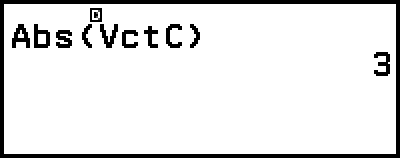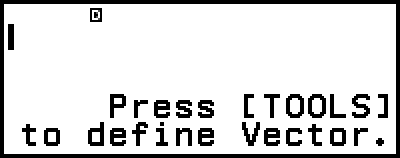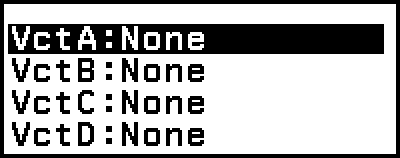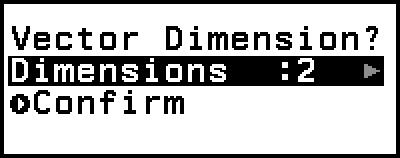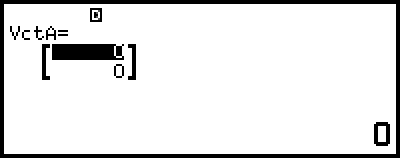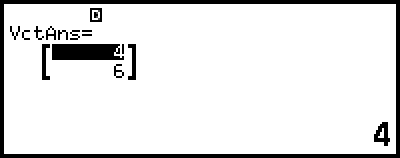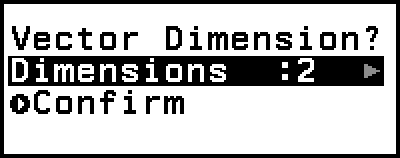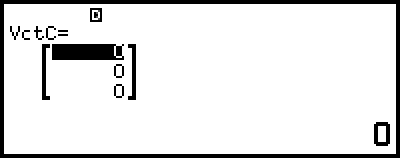Vector Calculations
Use the Vector app to perform two-dimensional and three-dimensional vector calculations.
General Procedure for Performing a Vector Calculation
To perform a vector calculation, use the special vector variables (VctA, VctB, VctC, VctD) as shown in the example below.
Example 1: To calculate (1, 2) + (3, 4)
When performing addition or subtraction of two vectors, they both must have the same dimensions.
1. Press  , select the Vector app icon, and then press
, select the Vector app icon, and then press  .
.
This displays the vector calculation screen.
2. Press  .
.
This displays the vector variable list screen.
For details about the vector variable list screen contents, and how to perform vector variable store, edit, or other operations, see "Vector Variable List Screen".
3. Perform the steps below to store (1, 2) to VctA.
(1) Select [VctA:], and then press  .
.
This displays the vector dimension setting screen (initial default setting: 2 dimensions).
(2) Here, we want to store a two-dimensional vector, so select [Confirm] and then press  .
.
This displays the Vector Editor for input of the two-dimensional vector for VctA.
(3) Input the elements of VctA.
- 1
 2
2
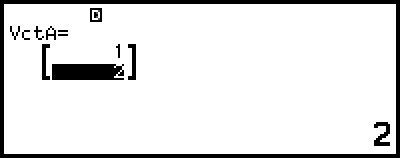
(4) Press  ,
,  , or
, or  to return to the vector calculation screen.
to return to the vector calculation screen.
4. Perform the steps below to store (3, 4) to VctB.
(1) Press  , select [VctB:], and then press
, select [VctB:], and then press  .
.
(2) Select [Confirm], and then press  .
.
(3) Input the elements of VctB.
- 3
 4
4
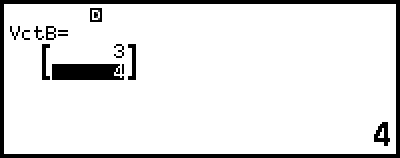
(4) Press  ,
,  , or
, or  to return to the vector calculation screen.
to return to the vector calculation screen.
5. Input VctA+VctB.
 – [Vector] > [VctA]
– [Vector] > [VctA]

 – [Vector] > [VctB]
– [Vector] > [VctB]
6. Press  .
.
This displays the VctAns (Vector Answer Memory) screen with the calculation result.
For details about VctAns, see "Vector Answer Memory (VctAns)".
Pressing  while the VctAns screen is displayed returns to the vector calculation screen and clears the calculation expression. Pressing
while the VctAns screen is displayed returns to the vector calculation screen and clears the calculation expression. Pressing  or
or  returns to the calculation expression input complete state in step 5 of this procedure.
returns to the calculation expression input complete state in step 5 of this procedure.
Note
While the Vector Editor or the VctAns screen is displayed, you can store the currently highlighted value to a variable. While the vector calculation screen is displayed and a calculation result value is on the screen, you can store the displayed calculation result to a variable. For details about variables, see "Variables (A, B, C, D, E, F, x, y, z)".
Vector Variable List Screen
The vector variable list screen is the entry portal you should use when you want to store a vector into vector variable VctA, VctB, VctC, or VctD, or to edit a previously stored vector. The status of each vector variable is indicated as shown in the examples below.
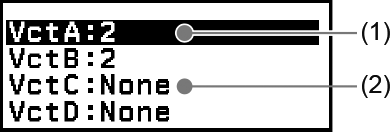
(1) 2
Indicates a two-dimensional vector is stored to the vector variable.
(2) None
Indicates that nothing is stored to the vector variable.
Displaying the vector variable list screen
Depending on the currently displayed screen, perform one of the operations below.
When the vector calculation screen is displayed:
Press  .
.
When the Vector Editor or VctAns screen is displayed:
Press  , select [Define Vector], and then press
, select [Define Vector], and then press  .
.
Storing New Data to a Vector Variable
Example 2: To store the three-dimensional vector (1, 2, 3)
1. While the vector calculation screen is displayed, press  to display the vector variable list screen.
to display the vector variable list screen.
2. Select the vector variable (VctA, VctB, VctC, or VctD) to which you want to store new data, and then press  .
.
If you selected a vector variable whose status is "None", advance to step 4 of this procedure.
If you selected a vector variable that already has a vector stored to it, a menu screen will appear. Advance to step 3.
3. Select [Define New], and then press  .
.
4. On the "Vector Dimension?" screen that appears, specify the vector dimension.
To specify three dimensions, perform the steps below.
(1) Select [Dimensions] and then press  .
.
(2) On the menu that appears, select [3 Dimensions] and then press  .
.
5. After the dimension specification is the way you want, select [Confirm] and then press  .
.
This displays the Vector Editor.
6. Input the elements of the vector variable.
- 1
 2
2 3
3
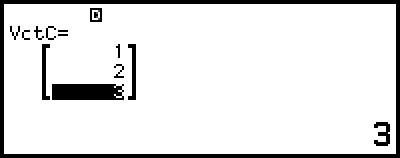
7. Press  ,
,  , or
, or  to return to the vector calculation screen.
to return to the vector calculation screen.
Note
Vector variable contents are retained even if you press  or turn off the calculator. Executing any one of the operations below causes the contents of all vector variables to be cleared.
or turn off the calculator. Executing any one of the operations below causes the contents of all vector variables to be cleared.
- Returning to the HOME screen and launching another calculator app
-  – [Reset] > [Settings & Data]
– [Reset] > [Settings & Data]
-  – [Reset] > [Initialize All]
– [Reset] > [Initialize All]
Editing Vector Variable Data
1. While the vector calculation screen is displayed, press  to display the vector variable list screen.
to display the vector variable list screen.
2. Select the vector variable (VctA, VctB, VctC, or VctD) you want to edit, and then press  .
.
3. On the menu that appears, select [Edit] and then press  .
.
This displays the Vector Editor.
4. Use the Vector Editor to edit the elements of the vector.
Move the cursor to the cell that contains the element you want to change, input the new value, and then press  .
.
5. Press  ,
,  , or
, or  to return to the vector calculation screen.
to return to the vector calculation screen.
Copying Vector Variable (or VctAns) Contents
1. Display the Vector Editor or VctAns screen of the vector variable you want to use as the copy source.
To display the Vector Editor, perform steps 1, 2, and 3 under "Editing Vector Variable Data".
To display the VctAns screen, perform the steps below while the vector calculation screen is displayed.
 – [Vector] > [VctAns]
– [Vector] > [VctAns] 
2. Select the vector variable copy destination.
For example, to copy to VctD, perform the following operation:  – [Store] > [VctD].
– [Store] > [VctD].
This displays the Vector Editor with the contents of the copy destination.
3. Press  ,
,  , or
, or  to return to the vector calculation screen.
to return to the vector calculation screen.
Vector Answer Memory (VctAns)
Whenever the result of a calculation executed in the Vector app is a vector, the VctAns screen will appear with the result. The result also will be stored to a variable named "VctAns".
The VctAns variable can be used in calculations as described below.
To insert the VctAns variable into a calculation, perform the following operation:  – [Vector] > [VctAns].
– [Vector] > [VctAns].
Pressing any one of the following keys while the VctAns screen is displayed switches automatically to the vector calculation screen, with "VctAns" followed by the operator or function of the key you pressed:  ,
,  ,
,  ,
,  ,
,  ,
,  ,
,  ,
, 
 (
( ),
), 
 (
( ).
).
Note
VctAns contents are retained even if you press  or turn off the calculator. Performing any one of the operations below causes the VctAns contents to be cleared.
or turn off the calculator. Performing any one of the operations below causes the VctAns contents to be cleared.
- Returning to the HOME screen and launching another calculator app
- Executing  – [Reset] > [Settings & Data]
– [Reset] > [Settings & Data]
- Executing  – [Reset] > [Initialize All]
– [Reset] > [Initialize All]
Vector Calculation Examples
The examples below use VctA = (1, 2) and VctB = (3, 4), and VctC = (2, -1, 2).
Example 3: VctA • VctB (Vector dot product)

 – [Vector] > [VctA]
– [Vector] > [VctA]
 – [Vector] > [Vector Calc] > [Dot Product]
– [Vector] > [Vector Calc] > [Dot Product]
 – [Vector] > [VctB]
– [Vector] > [VctB]
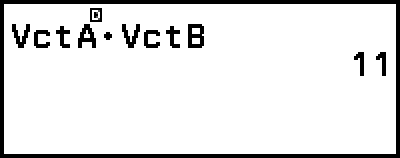
Note
When calculating a dot product, the dimensions of the two vectors must be the same.
Example 4: VctA × VctB (Vector cross product)

 – [Vector] > [VctA]
– [Vector] > [VctA]
 – [Vector] > [Vector Calc] > [Cross Product]
– [Vector] > [Vector Calc] > [Cross Product]
 – [Vector] > [VctB]
– [Vector] > [VctB]
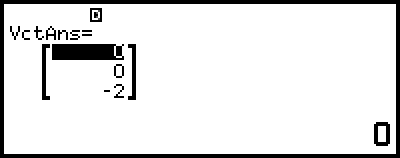
Note
When calculating a cross product, the dimensions of the two vectors must be the same.
Example 5: To determine the angle formed by VctA and VctB to three decimal places. (Number Format: Fix 3, Angle Unit: Degree)
 – [Vector] > [Vector Calc] > [Angle]
– [Vector] > [Vector Calc] > [Angle]
 – [Vector] > [VctA]
– [Vector] > [VctA]

 (,)
(,) – [Vector] > [VctB]
– [Vector] > [VctB]

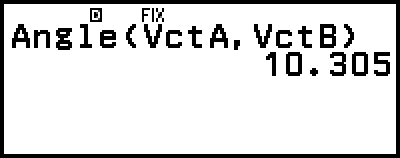
Note
When calculating an angle formed by two vectors, the dimensions of the two vectors must be the same.
Example 6: To normalize VctB
 – [Vector] > [Vector Calc] > [Unit Vector]
– [Vector] > [Vector Calc] > [Unit Vector]
 – [Vector] > [VctB]
– [Vector] > [VctB]

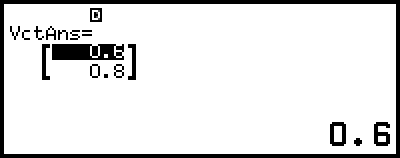
Example 7: To obtain the absolute values of VctC

 – [Numeric Calc] > [Absolute Value]
– [Numeric Calc] > [Absolute Value]
 – [Vector] > [VctC]
– [Vector] > [VctC]


